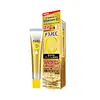What's inside
What's inside
 Key Ingredients
Key Ingredients

 Benefits
Benefits

 Concerns
Concerns

 Ingredients Side-by-side
Ingredients Side-by-side

Butylene Glycol
HumectantPropanediol
SolventIsopentyldiol
HumectantPropylene Glycol
HumectantPEG-8
HumectantWater
Skin ConditioningAscorbic Acid
AntioxidantAlcohol
AntimicrobialPPG-6-Decyltetradeceth-30
EmulsifyingParfum
MaskingTocopherol
AntioxidantPyridoxine Hcl
Skin ConditioningAllantoin
Skin ConditioningO-Cymen-5-Ol
AntimicrobialAscorbyl Tetraisopalmitate
AntioxidantSodium Metabisulfite
AntioxidantAlpinia Katsumadai Seed Extract
Skin ConditioningDisodium EDTA
3-O-Ethyl Ascorbic Acid
Skin ConditioningAscorbyl Glucoside
AntioxidantSerine
MaskingCitrus Limon Fruit Extract
MaskingCitrus Grandis Fruit Extract
AstringentButylene Glycol, Propanediol, Isopentyldiol, Propylene Glycol, PEG-8, Water, Ascorbic Acid, Alcohol, PPG-6-Decyltetradeceth-30, Parfum, Tocopherol, Pyridoxine Hcl, Allantoin, O-Cymen-5-Ol, Ascorbyl Tetraisopalmitate, Sodium Metabisulfite, Alpinia Katsumadai Seed Extract, Disodium EDTA, 3-O-Ethyl Ascorbic Acid, Ascorbyl Glucoside, Serine, Citrus Limon Fruit Extract, Citrus Grandis Fruit Extract
Water
Skin ConditioningGlycerin
HumectantPanthenol
Skin ConditioningHippophae Rhamnoides Fruit Water
SolventSodium Ascorbyl Phosphate
AntioxidantSaccharide Isomerate
HumectantOxalis Triangularis Extract
Skin ConditioningThymus Vulgaris Extract
PerfumingMalva Sylvestris Flower Extract
Skin ConditioningRosa Multiflora Fruit Extract
MaskingSchisandra Chinensis Callus Extract
Skin ProtectingAquilegia Sibirica Flower/Leaf/Stem Extract
HumectantHydrolyzed Rice Protein
Skin ConditioningRetinyl Palmitate
Skin ConditioningTocopheryl Acetate
AntioxidantSodium Hyaluronate
HumectantSodium Citrate
BufferingHydroxyethylcellulose
Emulsion StabilisingCaprylyl/Capryl Glucoside
CleansingSodium Cocoyl Glutamate
CleansingGlyceryl Caprylate
EmollientPolyglyceryl-6 Oleate
EmulsifyingSodium Surfactin
CleansingCitric Acid
BufferingBenzyl Alcohol
PerfumingEthylhexylglycerin
Skin ConditioningSodium Benzoate
MaskingPotassium Sorbate
PreservativeParfum
MaskingCI 16255
Cosmetic ColorantCI 15985
Cosmetic ColorantLinalool
PerfumingWater, Glycerin, Panthenol, Hippophae Rhamnoides Fruit Water, Sodium Ascorbyl Phosphate, Saccharide Isomerate, Oxalis Triangularis Extract, Thymus Vulgaris Extract, Malva Sylvestris Flower Extract, Rosa Multiflora Fruit Extract, Schisandra Chinensis Callus Extract, Aquilegia Sibirica Flower/Leaf/Stem Extract, Hydrolyzed Rice Protein, Retinyl Palmitate, Tocopheryl Acetate, Sodium Hyaluronate, Sodium Citrate, Hydroxyethylcellulose, Caprylyl/Capryl Glucoside, Sodium Cocoyl Glutamate, Glyceryl Caprylate, Polyglyceryl-6 Oleate, Sodium Surfactin, Citric Acid, Benzyl Alcohol, Ethylhexylglycerin, Sodium Benzoate, Potassium Sorbate, Parfum, CI 16255, CI 15985, Linalool
 Reviews
Reviews

Ingredients Explained
These ingredients are found in both products.
Ingredients higher up in an ingredient list are typically present in a larger amount.
Parfum is a catch-all term for an ingredient or more that is used to give a scent to products.
Also called "fragrance", this ingredient can be a blend of hundreds of chemicals or plant oils. This means every product with "fragrance" or "parfum" in the ingredients list is a different mixture.
For instance, Habanolide is a proprietary trade name for a specific aroma chemical. When used as a fragrance ingredient in cosmetics, most aroma chemicals fall under the broad labeling category of “FRAGRANCE” or “PARFUM” according to EU and US regulations.
The term 'parfum' or 'fragrance' is not regulated in many countries. In many cases, it is up to the brand to define this term.
For instance, many brands choose to label themselves as "fragrance-free" because they are not using synthetic fragrances. However, their products may still contain ingredients such as essential oils that are considered a fragrance by INCI standards.
One example is Calendula flower extract. Calendula is an essential oil that still imparts a scent or 'fragrance'.
Depending on the blend, the ingredients in the mixture can cause allergies and sensitivities on the skin. Some ingredients that are known EU allergens include linalool and citronellol.
Parfum can also be used to mask or cover an unpleasant scent.
The bottom line is: not all fragrances/parfum/ingredients are created equally. If you are worried about fragrances, we recommend taking a closer look at an ingredient. And of course, we always recommend speaking with a professional.
Learn more about ParfumWater. It's the most common cosmetic ingredient of all. You'll usually see it at the top of ingredient lists, meaning that it makes up the largest part of the product.
So why is it so popular? Water most often acts as a solvent - this means that it helps dissolve other ingredients into the formulation.
You'll also recognize water as that liquid we all need to stay alive. If you see this, drink a glass of water. Stay hydrated!
Learn more about Water